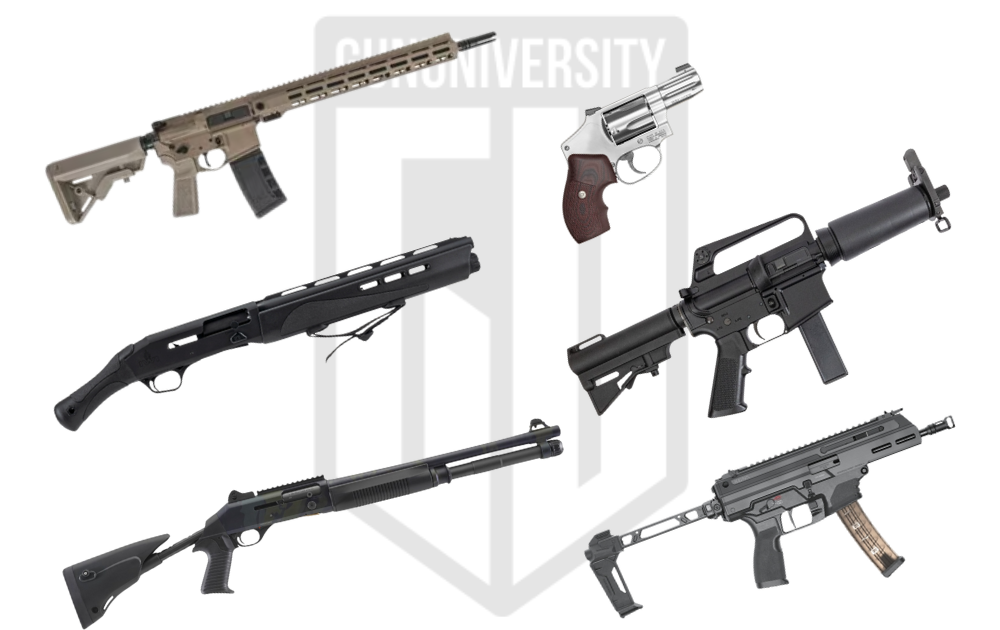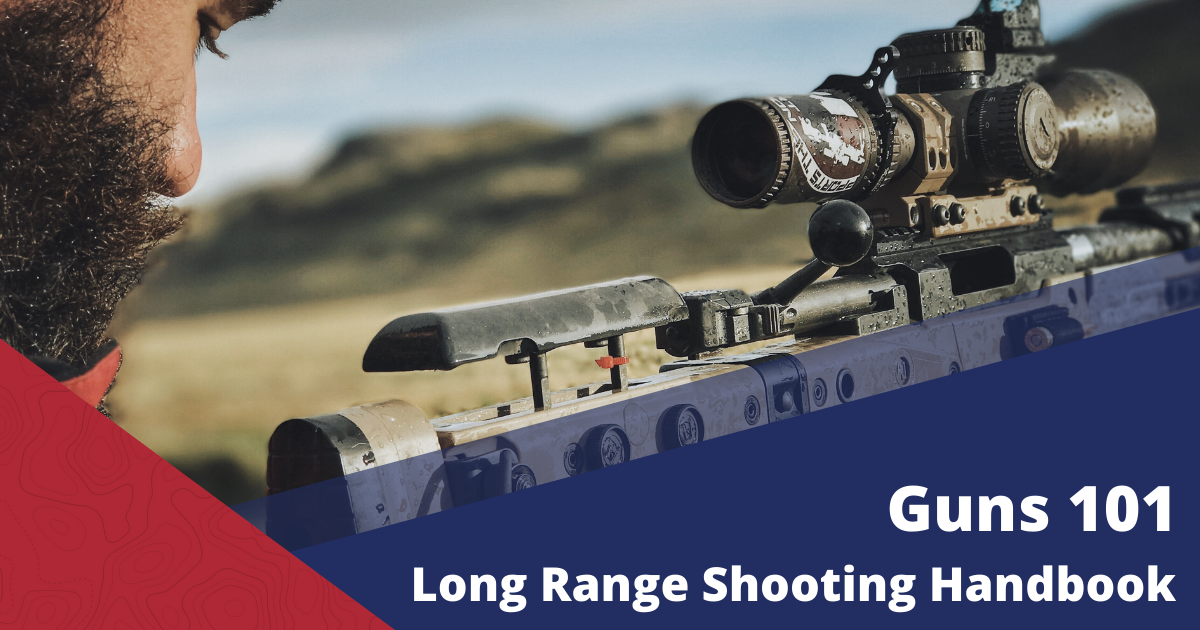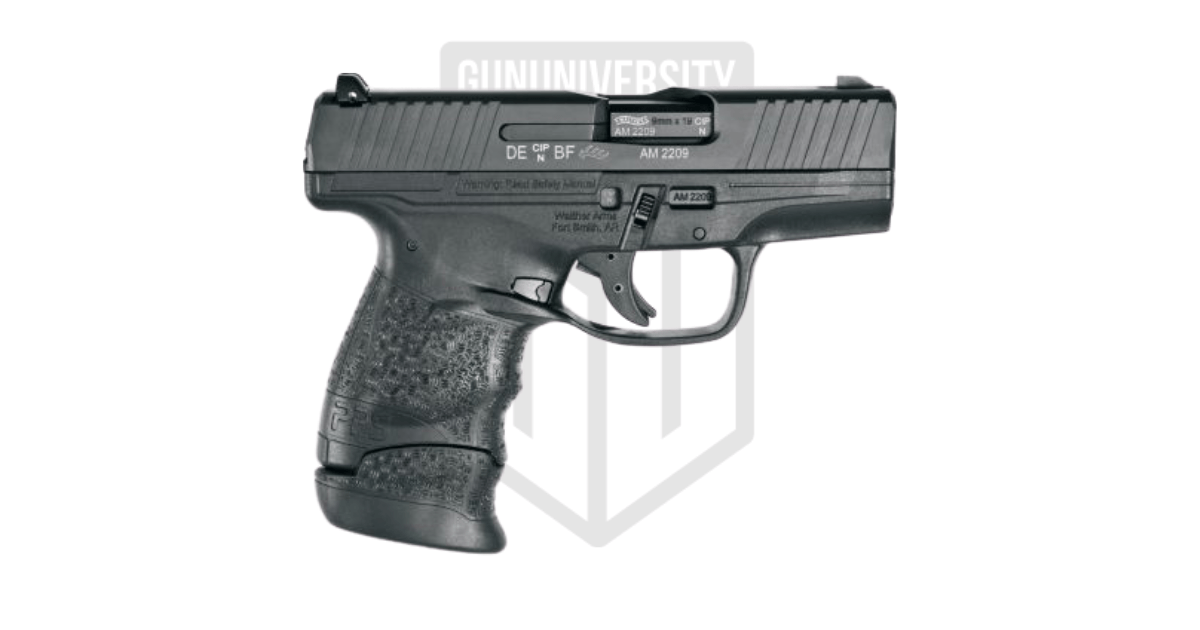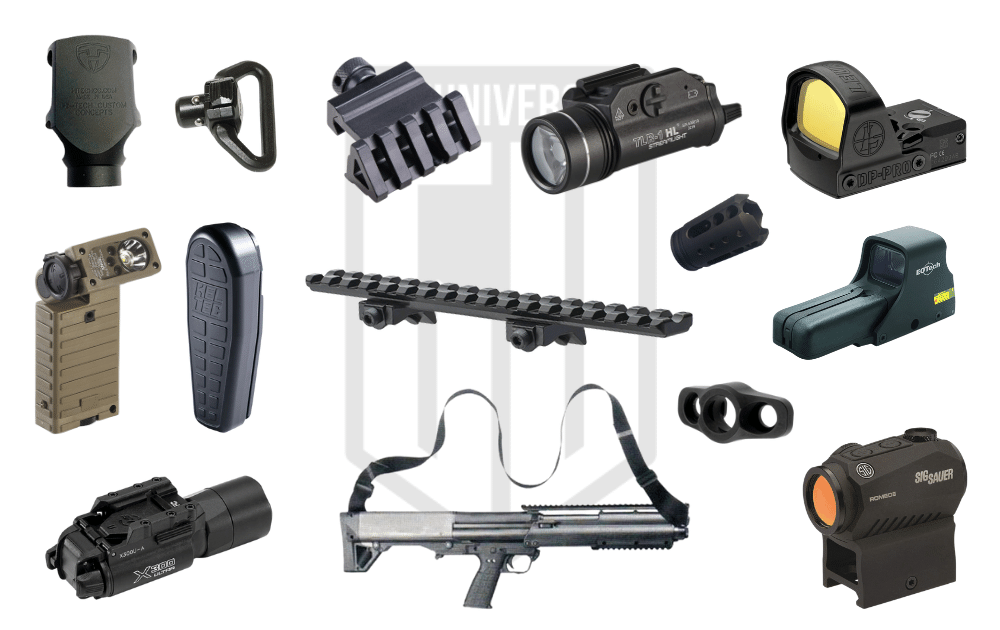Best Prism Scopes
There are three major types of optics for modern tactical rifles. We have red dots, a beloved close-range option. We have LPVOs that try to be a jack-of-trades choice. Finally, we have prism sights, which are often misunderstood and underappreciated. Underappreciated by everyone but me, I love Prism Sights, and today, I’m going to explain that love, but I won’t get emotional. Well, won’t get super emotional. I’ll stick to the facts and give you the reasons I love Prism Sights.
My time in the military was dominated by prismatic optics. The first is the Trijicon ACOG on my M16A4 rifle. This 4X scope was a game changer for Marines. The second was the slightly less loved MDO, or machine gu bday optic, which weighed 3.5 pounds and sat on my M240. It worked, but the M240 was heavy enough.
The prism sight has become a core memory for me and allowed me to gain a real appreciation for these optics. I used one in an occupational role, and I learned about their strengths and weaknesses.
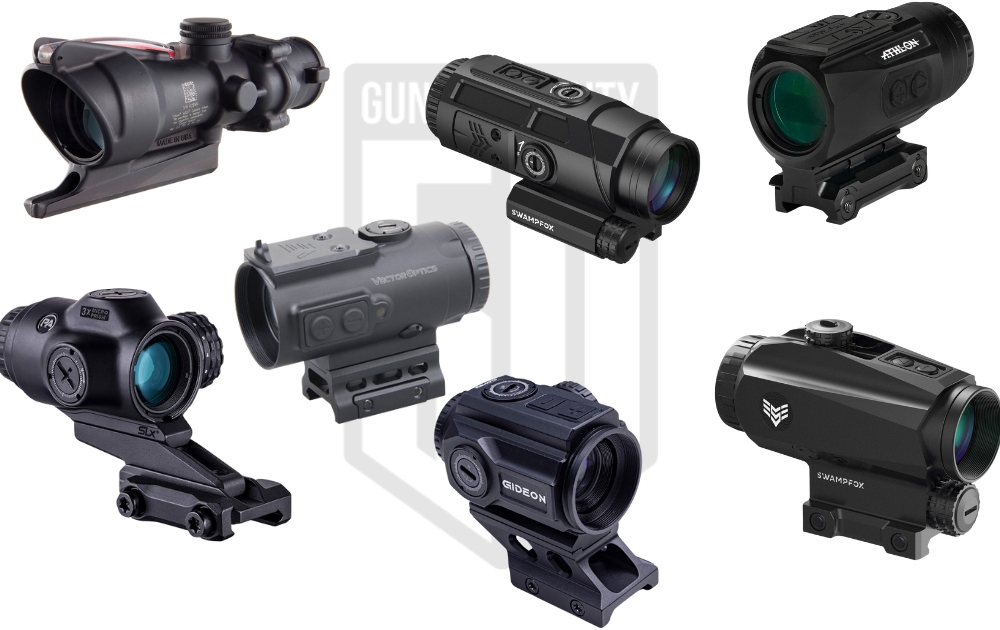
What’s a Prism Sight
By definition, a prism sight is an optic that uses a reflective prism for its image-erecting system. Typically, a magnified optic will use a series of relay lenses. These are fixed power optics by their nature. They come in a variety of magnification ratings that start at 1X or no magnification and tend to top out at 6X. Sure, you could go higher, but at that point, even the 6X optics are specialized tools for things like machine guns. The most popular magnification settings are 3X, 4X, and 5X.
The Benefits of Prism Sights
Prism sights provide a compact optic with a degree of magnification. These optics are much smaller than other magnified optics. They tend to be much lighter and require less rail space. Modern micro prism sights are packing 3X magnification in an optic the size of an Aimpoint T1.
The aim of a prism sight is to provide what I call carbine-length magnification. While plenty of rifles can shoot beyond 300 yards, the 300-yard mark is the typical carbine range. It’s the range most shooters, even with minimal training, can hit a man-sized target. A prism provides that carbine length magnification.
What about up close? Some shooters use an offset red dot, but with the illuminated reticle, you can use an occluded shooting technique. You keep both eyes open and focus your vision on the target. The illuminated reticle will glow and superimpose the reticle over your vision.
The simpler, fixed magnification design makes them typically more durable and capable of suffering from some serious abuse. Outside of the famed ACOG, most prism sights are fairly affordable optics. They even come with mounts, which, in most cases, makes them even more affordable.
The reticles used by prism optics are etched. In a situation where batteries die, or the electronics break, the optic is still useable.
Downsides of Prism Sights
The downside of prism sights is that they don’t offer the same magnification as an LPVO and the ease of close-range shooting as a red dot. They are a stopgap that doesn’t excel in any one role. They do a little bit of everything but tend to succeed only in the middle ground of shooting. Up close and far away, they can be a bit dodgy.
Prism sights also require you to get awfully close to the gun. Compared to other optic options, they have short eye relief. This results in some interesting techniques and mounts that have been developed to make this a little easier to deal with.
Gun University’s Choices of the Best Prism Scopes
Best Prism Scopes
Best Overall Trijicon ACOG |
| Check It Out | |
Best Lightweight Primary Arms SLx Micro Prism 3X | 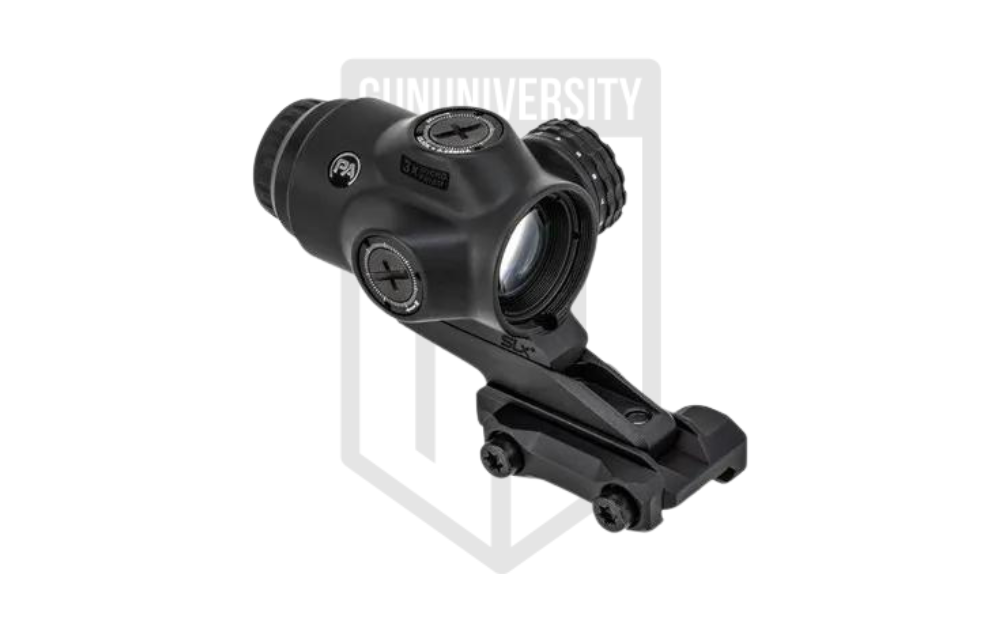 |
| Check It Out |
Best Budget-Worthy Swampfox Trihawk | 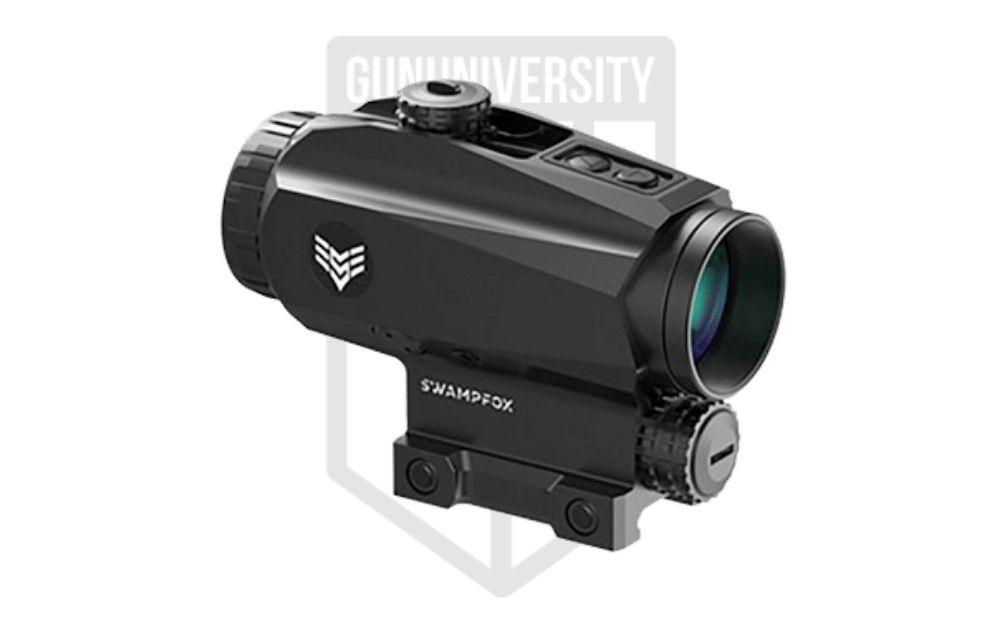 |
| Check It Out |
Best Underrated Vector Paragon 4X | 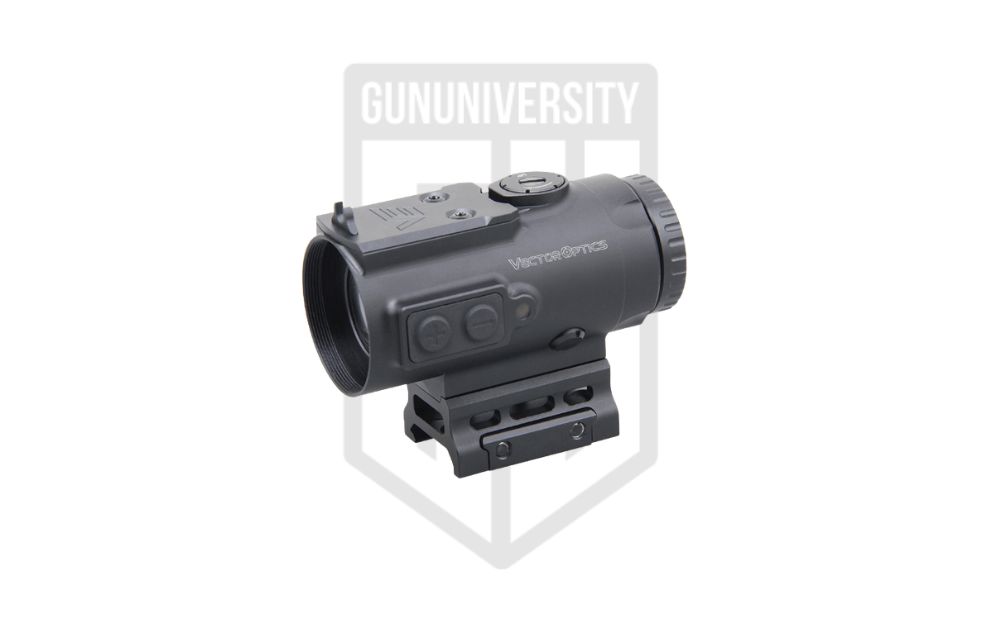 |
| Check It Out |
Best 5X Swampfox Saber 5X | 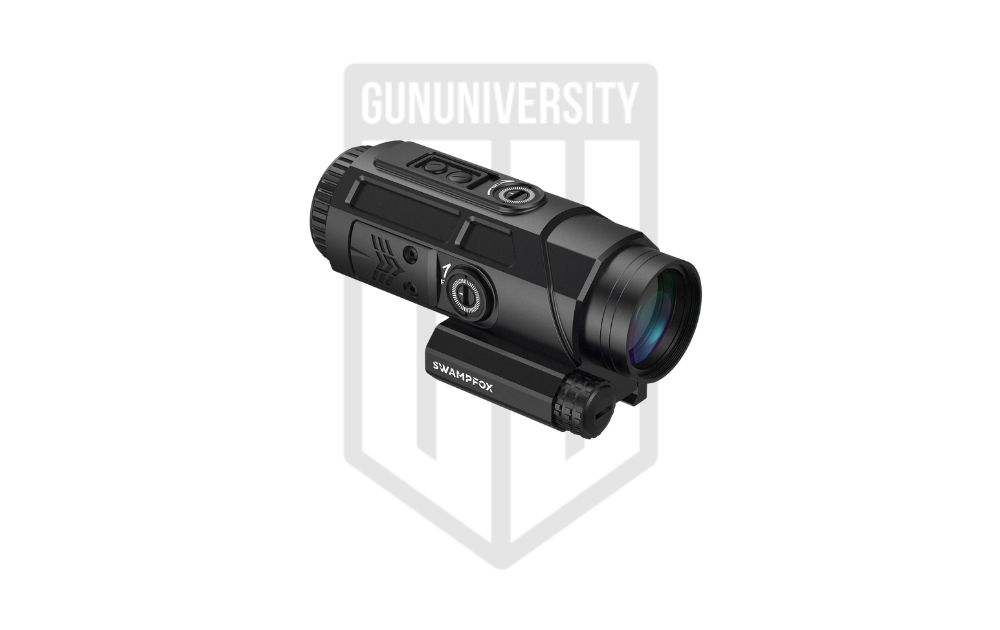 |
| Check It Out |
Our Choice in 1x Prism Gideon Optics Advocate | 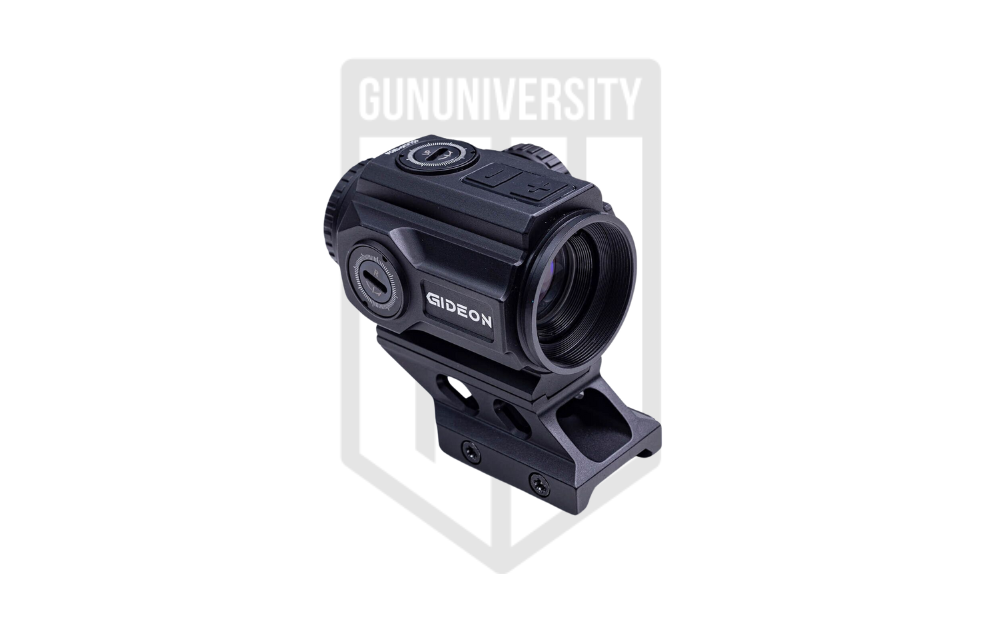 |
| Check It Out |
Remarkably Simple Athlon Midas Flare 3X Prism Sight | 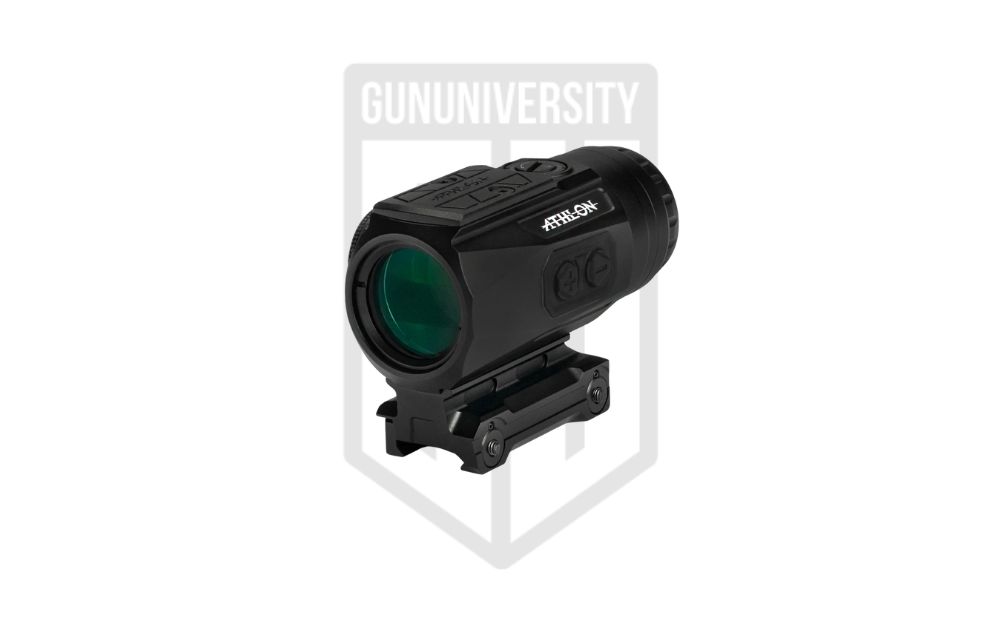 |
| Check It Out |
Best Prism Scopes – Reviews
1 Trijicon ACOG 4×32 BAC : Best Overall
- Clarity A+
- Shootability B+
- Reliability A+
- Features B+
Our Grade
A
Reader’s Grade
A+
Based on 2 Reviews
Your Grade
Do You Own This Accessory? Leave A Review
Success Your Grade Has Been
Added To Our Reader’s Score
We use email to verify the accuracy of our reviews. We promise to never spam you.
Trijicon ACOG 4×32 Specs
- Magnification 4X
- FOV 36.8 Feet
- Weight (oz) 15.1 ounces
- MSRP $1,593
Trijicon ACOG 4×32
What could I say to prove that ACOG is one of the best prism optics? It’s not the first by far, but it’s arguably the most successful and fielded prism sight ever made. The ACOG from Trijicon has been fielded by multiple branches. It was part of the Army’s SOPMOD Block II, and the USMC issued the ACOG to Marines far and wide. This 4×32 optic made a huge difference in the marksmanship abilities of Marines and allowed them to hit hard, faster, and further.
The Trijicon ACOG set the standard for prism optics and laid the blueprint for the current prism market. This includes the partially illuminated reticle and the built-in bullet drop compensator. The bullet drop compensator is matched to the round fired and the length of the barrel. This allows for easy and quick adjustments for various ranges, and it’s an easy button for those who might not know their dope and drop. I’ve always found the ACOG BDC to be remarkably accurate and very easy to use.
At the center sits an illuminated reticle that can vary from a circle, chevron, and more. The brightness of the reticle is automatically adjusted via the ambient light. That big red thing over the top of the optic is a mixture of tritium and fiber optics that absorb light and power the optic. It doesn’t get much simpler than that.
The view through the lens provides a super bright and clear view. The image is gorgeous and provides a very high-definition view that’s really fantastic. As a Marine, that clear view provided an easy way to spot threats, to observe, and to detect nearly anything well beyond normal eye range.
The downside to the ACOG is the abysmal eye relief. We were taught to put our nose to the charging handle to get a good, clear view through the optic. The mount sweeps the optic rearward to help, but man, you only get 1.5 inches of eye relief. If you can get past that, the ACOG delivers an extremely well-made, durable, and capable prismatic sight. It’s a professional-grade optic with a professional-grade price point.
Trijicon ACOG 4×32 Pros and Cons
- Excellent BDC
- Tough as Nails
- Super Clear Lenses
- Expensive
- Short Eye Relief
2 Primary Arms SLX 3X MicroPrism : Best Lightweight
- Reliability A+
- Value A
- Reticle A+
- Ergonomics A
- Glass A-
Our Grade
A
Reader’s Grade
TBD
Based on 0 Reviews
Your Grade
Do You Own This Accessory? Leave A Review
Success Your Grade Has Been
Added To Our Reader’s Score
We use email to verify the accuracy of our reviews. We promise to never spam you.
Primary Arms SLx Micro Prism 3X Specs
- Magnification 3X
- FOV 38 feet
- Weight 7.95 ounces
- MSRP $319.99
Primary Arms SLx Micro Prism 3X Review
Prism sights tend to be moderately sized and can be a little heavy. Primary Arms flipped the switch on the prism sights and introduced the world to the Primary Arms SLx MicroPrism series. These Microprism optics come in 5X and 3X varieties. The 3X model delivers my preferred feature set and size. The Primary Arms SLx 3X delivers a 3X optic that’s about the same size as an Aimpoint T2 and weighs about 8 ounces total.
That’s a lot of magnification for barely any size or weight. Snapping in behind the optic proves it’s small but also surprisingly clear and consistent. I’m impressed by the eye relief, which, at 2.7 inches, delivers a fairly generous eye relief option for a prism sight. The SLx Micro Prism offers a decent field of view that gives you 38 feet at 100 yards. The Primary Arms SLx series also delivers a ton of different reticle options.
I tend to prefer the ACSS Raptor version. The Raptor variant comes in 5.56/.308, as well as 7.62×39 and .300 Blackout. Users can also get hands-on with the ACSS Aurora, Aurora MIL, and probably more. The SLx Micro Prism 3X also comes with a ton of different mounting options. It’s one of the few prism sights that can be easily mounted to a wide variety of weapons with its variety of optic mounts. The SLx series can also use mini-ACOG mounts if the included options aren’t good enough.
The illuminated portion of the reticle gives you thirteen different settings, and the highest settings are truly daylight bright. Of course, if the battery dies, the reticle is etched, so it’s still functional. In terms of clarity, the view is nice and clear. Sure, it’s not as good as the 1,200-dollar ACOG, but it’s pretty close to a quarter of the price.
Primary Arms SLx Micro Prism 3X Pros and Cons
- Affordable
- Super Small and light
- Daylight Bright Reticle
- TTight Eyebox
3 Swampfox Trihawk : Best Budget-Worthy
- Reliability A-
- Value A+
- Reticle A-
- Ergonomics B
- Glass B+
Our Grade
A-
Reader’s Grade
A+
Based on 1 Reviews
Your Grade
Do You Own This Accessory? Leave A Review
Success Your Grade Has Been
Added To Our Reader’s Score
We use email to verify the accuracy of our reviews. We promise to never spam you.
Swampfox Trihawk Specs
- Magnification 3X
- FOV 52 Feet
- Weight 15.4 ounces
- MSRP $289
Swampfox Trihawk Review
I got hit with the hammer of surprise when I started using the Trihawk. It was a budget-worthy prism optic from what was, at the time, a fairly new company. I didn’t expect much, but I was happy to be wrong. Unlike many other prism optics, the Trihawk accepted the idea of being big and bad and using that size. What’s the size give you that makes it worth the cost of admission?
It hits your eyes hard with a huge field of view. Most prism sights have a fairly average field of view, but the Trihawk gives you a massive 52-foot field of view at 100 yards. It’s almost twice the competition. This huge field of view makes it easy to track targets with minimal movements and helps keep you from getting sucked into a limited field of view. That kind of field of view is absolutely wonderful to have.
Of course, the optic is big, and weighs 15.4 ounces total. It’s 3.343 inches tall and over 4.5 inches wide. It’s no micro prism. The Trihawk does give you excellent visibility and a clear view that makes it easy to soak up the details of the world in front of you. Spotting targets at range is easy, and that big window certainly helps.
The Trihawk is a 3X prism optic that comes with a built-in mounting system and two reticle options. You can use the bullet drop compensating reticle for 5.56 rifles or the MOA design, which can easily work with any caliber. A lot of prism sights stick you with a BDC, typically a .556 BDC, and cal lit good. Options are nice, and other calibers exist outside fo 5.56.
My biggest fault with the Swampfox Trihawk is the reticle visibility. It’s not quite daylight bright. It’s daylight dim. The optic can’t summon the juice to get that eye-catching brightness of other optics.
Swampfox Trihawk Pros and Cons
- Massive Field of View
- Affordable
- Multiple Reticle options
- Big
- Reticle Isn’t Bright
4 Vector Paragon : Best Underrated
- Reliability A+
- Value A+
- Reticle A+
- Ergonomics A-
- Glass B
Our Grade
A
Reader’s Grade
TBD
Based on 0 Reviews
Your Grade
Do You Own This Accessory? Leave A Review
Success Your Grade Has Been
Added To Our Reader’s Score
We use email to verify the accuracy of our reviews. We promise to never spam you.
Vector Paragon 4X
- Magnification 4X
- FOV 28.8 feet
- Weight 8.8 ounces
- MSRP $269
Vector Paragon 4X Review
If you like magnification but hate spending money, the Vector Paragon is for you. The Paragon isn’t just a good budget optic; it’s one of the better prisms on the market. It just so happens to be remarkably affordable. The Paragon comes in numerous magnification options, including 4X, 3X, and 1X. All are fine, but the 4X option would be my go-to, it’s my preferred option for prism magnification levels.
The Paragon also comes ready to mount a piggy backed red dot. Paragon offers you a discount if you purchase their red dot with the Vector. I can’t speak to the quality of their red dots, but the prism sights are downright awesome. The image through the optic is incredibly clear with edge to edge clarity.
The Paragon packs 3.65-inches of eye relief, which is about double the average for a 4X prism. The reticle is built around the 5.56 cartridge and features a three quarter circle with a dot and ladder in the center to compensate for bullet drop at multiple ranges. Surpsingly the reticle amps up the brightness and it looks great in full sunlight. Not quite eye catching, but you can see the illumination.
The Paragon even has a rear sight built into the top of your optic. It aligns with a front sight and gives you a built in backup. There is a lot to love, but a little to dislike. The mount screws are quite small and I’d like a larger bolt I could get more torque out of. Additionally, the 1 MOA adjustments just feel a bit broad for a 4X optic.
Vector Paragon 4X Pros and Cons
- Daylight Bright Reticle
- Crystal Clear Optics
- Spare Rail For Mini Red Dot
- Limited Reticle Options
5 Swampfox Saber : Best 5x
- Reliability A-
- Value A+
- Reticle A-
- Ergonomics B
- Glass B+
Our Grade
A-
Reader’s Grade
TBD
Based on 0 Reviews
Your Grade
Do You Own This Accessory? Leave A Review
Success Your Grade Has Been
Added To Our Reader’s Score
We use email to verify the accuracy of our reviews. We promise to never spam you.
Swampfix Saber 5X
- Magnification 5X
- FOV 30.9 feet
- Weight 24.7 ounces
- MSRP $299.99
Swampfox Saber 5X Review
Powerful prisms can be a tricky thing. When we get past 4X, it can be a little much. The 5X prism makes it tough to use at closer ranges, but prisms don’t perform well as comparable LPVOs. If I had to toss a 5X prism on my rifle, it would be the Swampfox Saber. The Swampfox Saber provides the power of a 5X prism combined with the versatility to be used at a multitude of ranges.
The Saber comes complete with two mounting platforms to directly attach red dots with an RMSc footprint. You can attach one to the right, one to the left, or even both if you so choose. This makes it easy to use the Saber at expanded ranges to take advantage of the 5X power, and the red dot allows you to place precision shots up close.
The Saber is a big, hefty thing, and like most Swampfox prisms, the bragging point is the field of view. At 100 yards, the Saber delivers a 30.9-foot field of view. That’s huge, and from what I’ve found, it’s the widest field of view on the market for a 5X prism. That kind of field of view makes it easy to track moving targets, find targets, and watch a designated area.
Inside the Saber sits a reticle designed to provide ballistic drop points for both 5.56 and .308. They are a little different, so consult the manual to get the right holdover for your caliber and rifle. The reticle is illuminated, but don’t expect what I’d think of daylight bright. It’s fine, but it doesn’t reach ACOG levels.
At 299, it’s also not coming close to the ACOG price point. What is surprisingly comparable is the clarity. The Swmapfox might be made in China, but the glass is fantastic. It’s a pleasant surprise for a budget-friendly optic.
The Saber gives us a versatile 5X prism with close-range capabilities, a huge field of view, great class clarity, and a stellar price point. What it doesn’t give is a lightweight design. At 24.7 ounces, this is a hefty beast, and it will make a carbine feel like a rifle.
Swampfox Saber 5X Pros and Cons
- Red Dot Ready
- Massive FOV
- Awesome Reticle
- Heavy
6 Gideon Optics Advocate : Our Choice in 1X Prism
- Reliability A-
- Value B
- Reticle A
- Ergonomics B
- Glass B
Our Grade
B+
Reader’s Grade
TBD
Based on 0 Reviews
Your Grade
Do You Own This Accessory? Leave A Review
Success Your Grade Has Been
Added To Our Reader’s Score
We use email to verify the accuracy of our reviews. We promise to never spam you.
Gideon Optics Advocate
- Magnification 1X
- FOV 79 Feet
- Weight 5.5 ounces
- MSRP $2,229.99
Gideon Optics Advocate Review
So far, every prism optic has had some degree of magnification. Most prism optics take advantage of the design by being magnified. There is a niche market for 1X prisms, and we couldn’t not include one. These 1X Prism fight for the same place on your rifle as a red dot but offer a few advantages over the red dot. Our choice in 1X prism is the Gideon Optics Advocate.
The Advocate offers shooters a 1X Prism with a very bright reticle that’s fighting for that daylight bright rating. The reticle is also etched, meaning shooters with astigmatism won’t suffer from reticle bloom and will always have a nice, clear image. The reticle is a segmented circle with a chevron in the center. It’s attention-grabbing and more dynamic than most red dot reticles.
The Advocate comes with both a low and high mount, so it can be adapted to be used on a wide variety of weapons, from ARs and AKs to CZ Scorpions and more. It drops on and gives you a very usable alternative to a red dot. The Advocate’s design keeps its low profile, and the dot is approximately the same size as compact red dots.
Unlike red dots, you do have to contend with eye relief, and the Advocate gives you 3.34 inches. That’s a fiat bit generous, and the rearward raking mount helps make it so. It’s equipped with shake awake technology, so the batteries last nearly forever. Finally, the Advocate won’t break the bank. It’s less than 250 dollars and ready to go out of the box.
Gideon Optics Advocate Pros and Cons
- Affordable
- Great Red Dot Alternative
- Great Reticle
- Still Have to Deal With Eye Relief
7 Athlon Midas Flare 3X : Remarkably Simple
- Reliability A-
- Value A+
- Reticle A-
- Ergonomics A-
- Glass A-
Our Grade
A-
Reader’s Grade
TBD
Based on 0 Reviews
Your Grade
Do You Own This Accessory? Leave A Review
Success Your Grade Has Been
Added To Our Reader’s Score
We use email to verify the accuracy of our reviews. We promise to never spam you.
Athlon Midas Flare 3X
- Magnification 3X
- FOV 32.5 feet
- Weight 14.3 ouces
- MSRP $279.99
Athlon Midas Flare 3X Prism Sight Review
Athlon Optics doesn’t get the credit it deserves. They produce some awesome optics and do so at a fair price point. Athlon gets a good rep for their LPVO and red dots, but their prism sights are stellar. The Midas Flare 3X is a simplistic prism optic with a versatile reticle, modular nature, and a rough and tough design.
The reticle comes in red and green and consists of a half circle with a series of hashmarks underneath it. We get 10 daylight settings and 2 nightvision. The reticle in this thing gets surprisingly bright. It’s daylight bright, and it might not be ACOG bright, but it’s bright enough to be eye-catching. It’s downright impressive for a mid-priced optic.
Up top, a mount allows you to toss on a micro red dot. This gives you a 1X option. It’s a direct-mount footprint that’s RMR compatible. This little extra mount is a nice touch. It’s not totally necessary since a 3X prism works pretty well up close with a two-eyed open shooting style.
The Midas 3X Flare uses a solid one-piece mount that’s tough to beat when it comes to durability and ultimately simplicity. No mount loosens up and throws off your zero. Less to break, and less to deal with all together. The downside is that it only works for AR-type carbines with inline stocks. On other guns, it might feel like it sits quite high.
The Midas 3X Flare gives us some of the best reticle brightness we’ll see at this price point. Being able to add a red dot to the Midas gives us a true 1X level of performance. A one-piece mount locks us into one type of rifle, but provides a high level of durability. The Midas is a solid contender at its price point and an option that’s slept on by and large.
Athlon Midas Flare 3X Prism Sight Pros and Cons
- Affordable
- Daylight bright reticle
- Excellent Reticle Design
- AR Centric Design
A Prism of Light
Prismatic sights are the ultimate carbine optic as far as I’m concerned. While the Recce LPVO is cool, and the close-quarters red dot is great, the prism is what works best for the typical carbine owner. It’s not going to be the coolest option, but for a lot of shooters, it can be the most practical. Give the prism a try, and let us know what you think below.
Recent Posts
December 15, 2025
December 15, 2025
December 12, 2025
December 12, 2025


